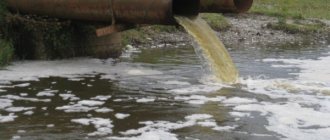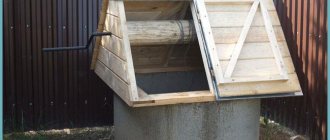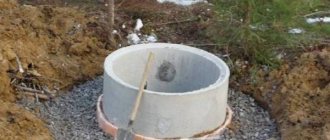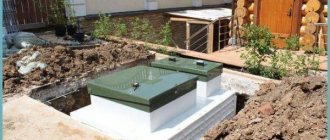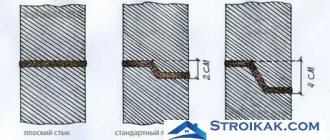To fully enjoy the fruits of civilization, living in a suburban area far from urban life support systems, you can organize them yourself. For example, drill a well for water supply, build a septic tank for sewerage. The latter becomes an important element of life outside the city, because it ensures maximum purification of sewage effluents coming from the house. Septic tanks are different, and they are built from different building materials: brick, stone, blocks and reinforced concrete finished products. Here we will consider a septic tank made of concrete rings.
Septic tank made of concrete rings for a private house
The term “septic tank” is clearly defined by the state standard under number 25150-82. This document clearly states that a septic tank is a structure in which mechanical wastewater treatment is carried out, where processes such as sedimentation and anaerobic fermentation of the resulting sludge are used. That is, to a greater extent, cleaning is carried out precisely by settling.
Such facilities purify contaminated water by 65%. To bring this figure to 100%, additional filtration elements are built: fields, wells, ditches, trenches, etc., which are laid in the ground. It is the latter that performs the functions of a filter.
For septic tanks made of reinforced concrete rings, standard products with a height of 0.9 m and a diameter of 1, 1.2, 1.5, 1.7 or 2 m are used.
Pros and cons of the system
Let's start with the advantages:
- High structural strength that can withstand loads from frost heaving of the soil.
- The service life is almost unlimited.
- This is a non-volatile structure if the wastewater is supplied by gravity.
- Easy to install. Can be done manually if the installation is carried out at a shallow depth.
- Small cash outlay.
- A septic tank of this type can be used in houses where people permanently live.
- Almost zero maintenance. It is recommended to clean the septic tank of sludge once a year.
Flaws:
- Cannot be installed at a high groundwater level - not lower than 1.3 m.
- If special equipment is used during the installation process, the costs increase sharply.
- Additional filtration structures take up a lot of space on the site. Plus there are additional costs.
- If wastewater is forced into the septic tank, the structure immediately becomes volatile.
Attention! Unpleasant odors will not be a problem if ventilation is properly organized.
Advantages of concrete wells
The use of concrete rings in the construction of wells is an effective and cost-effective solution due to a number of factors. Among them:
- affordable cost of concrete, reinforcement and, as a result, low price of structural elements;
- increased resistance of seam concrete products to soil shear;
- a wide range of designs with a wide range of sizes, allowing for the construction of communications for various purposes;
- high level of structural strength and reliability;
- durability of the structure, which is estimated at a service life of at least 20 years;
- high frost resistance;
- low surface permeability, which allows the use of products under conditions of exposure to aggressive environments;
- moisture resistance;
- cost-effectiveness of the structure;
- high degree of resistance to compressive loads arising during operation due to soil pressure;
- high speed and ease of installation work.
Design features, nuances of use
Purely structurally, a septic tank is a well assembled from reinforced concrete rings installed on top of each other. If the volume of sewage discharged is no more than 1 m³/day, then one well is sufficient.
If the wastewater volume is 1-10 m³/day, then two wells are installed. This type of septic tank is called a two-chamber septic tank. If more than 10 m³/day of sewage is discharged into the sewer system, then there can be an infinite number of wells, depending on the volume of wastewater. On suburban private plots, structures of more than three wells are usually not used.
The arrangement of the latter relative to each other can be as follows: sequential, circular, letter “G”, etc. Here it is important to correctly connect the wells to each other, for which a regular plastic sewer pipe is used.
Attention! The number of chambers does not affect the quality of cleaning. The larger influence is the volume of the structure. The larger it is, the more intense the sedimentation of sewage occurs.
Installation technology
The installation of concrete rings begins with the design stage, at which, first of all, it is necessary to determine the location, as well as the desired depth of the well. The amount of depth depends on the purpose. If the well is a source of water, then it is necessary to go as deep into the soil as possible in order to achieve maximum purity and transparency. The depth of drainage communications and cesspools depends on the load and the required capacity. Depending on the depth of the well, its purpose, and the type of soil, the design of the rings is selected between straight and seam type products. Straight rings are cheaper and justified for the construction of simple structures on stable ground. To select the type and size of rings, you can use the table values.
The parameters and characteristics of the rings are regulated by the regulatory requirements of the state standard GOST 8020-90. When calculating the volume of drainage wells, we proceed from the norms of need of 200 cubic liters of water per person per day. To calculate for a certain number of residents, a triple norm is used. When constructing wells for pipes and cable routes, the depth is determined by the depths at which the engineering systems and communications are located. The cost of the length of communications will depend on the location. In this regard, the choice of the optimal location is determined by the analysis of the free space factor. In this case, septic tanks and cesspools are located at a distance of no more than five meters from a residential building, drainage systems at the place of drainage or accumulation of liquid, wells for communication in the direction of connection. In accordance with the design documentation, material is purchased: rings of the required diameter and height in the required quantity, cement, bitumen insulation, crushed stone and sand. When laying pipes for other communications, components are purchased, including plugs, transitions, fittings, shut-off valves, inspection units and other necessary elements along the length of the route.
At the excavation stage, it is necessary to dig a pit of the required depth and width for the reserve. As a rule, the pit is made wider than the diameter of the ring by 10 - 15%. For installation, a base is formed, which, depending on the massiveness (number of reinforced concrete products used) and the purpose of the well, can be:
- a pillow made of crushed stone and sand, with a layer of at least 50 cm;
- concrete foundation, the organization of which requires formwork and mortar.
In the case of installation of communications on a concrete foundation, work on the installation and installation of rings can be carried out 10-14 days after pouring the foundation. This is due to the need to have at least half the strength of the base, which will be affected by the mass of all the rings.
When choosing the type of foundation, in some cases it is necessary to carry out geodetic research to determine the type of soil. Crushed stone in individual structures serves as a supporting base, as well as a filter. Special equipment is used to install reinforced concrete rings. The work is carried out by a team of qualified workers consisting of at least three people. In most cases, in order to ensure the strength and reliability of the technological structure, reinforced rings are used as lower structural elements. Reinforced concrete products are distinguished by the presence of a frame made of mesh with a diameter of 4-5 mm. At the same time, the product has thicker walls, which allow it to withstand loads in the form of the mass of the elements installed above. Experts recommend installing reinforced rings during the construction of large drainage pits, tunnels for heating networks and utilities, deep wells, sewers and gas pipelines. For convenient gripping, installation and positioning, reinforced concrete products are equipped with loops that allow the rings to be rigged using hooks or using a cable. The installation process of subsequent elements involves their sequential installation with end-to-end installation.
Rings with a straight design are installed on top of each other. In this case, the position is fixed using brackets made of metal. This design option is the least durable. In the case of unstable soil, it would be most appropriate to use seam concrete rings with a lock.
Their installation is carried out by combining technological protrusions and recesses, allowing you to build the most even and durable structure. Rings with a lock allow you to form a well structure that will not be subject to shifts over time, maintaining its integrity and tightness. In the event that it is impossible to construct a well from entire elements of the selected standard size, special auxiliary or additional rings are used. The upper part of wells is often built on the basis of concrete wall products, which are used in the construction of the neck.
In this case, the contact points are subject to additional processing and sealing. The most labor-intensive work is to seal the seams between blocks of a straight design without a seam connection into a groove. A cement mortar is used for this purpose, which is used to plaster the surfaces, followed by treating the seams with bitumen-based waterproofing materials. In the event that groundwater is close, in order to protect communications, it is necessary to apply a waterproofing layer on both sides: inside and outside.
At the top of the well, as a rule, a cover is installed in the form of a plate with a round hole for laying a hatch. A hermetically sealed hatch will prevent unpleasant odors. In addition, a closed well is a guarantee of safety for passers-by walking on the surface above the well. At the final stage, the soil adjacent to the well structure is backfilled and compacted. In some cases, the space between the concrete walls of the well and the ground is filled with sandy soil, which provides not only structural strength, but also allows maintaining high aeration and filtering qualities.
If there are communications in the form of pipes or cable routes, their entry is realized through the side technological holes in the rings. The entry point must be sealed.
When installing rings, installation technology with gradual deepening can be used. During the work, the rings are installed on unprepared soil and gradually sunk to the required depth by removing soil from the interior of the well. To move blocks of concrete rings, a hoist can be successfully used instead of a truck crane. Otherwise, the stages have no fundamental differences.
Having no experience in calculating building structures, as well as in the field of constructing wells, it is worth turning to professionals for help. Properly performed calculations and work planned in stages will reduce the cost of purchasing materials, the cost of construction and reduce the time required for installation work while maintaining the highest possible quality and durability of the structure.
How to correctly calculate capacity
To do this, two indicators are taken into account:
- The number of people permanently living in the house. Guests are not included.
- The amount of water consumed by one person per day. This is a standard value - 200 liters or 0.2 m³. This indicator includes: using the toilet, washing dishes, showering, washing and other procedures related to water.
For example, if there are 4 people living in a house. Then you need to build a septic tank with the following volume:
4 x 0.2 = 0.8 m³.
But there is one more indicator that is recommended to be taken into account when making calculations. This is the number of days during which bacteria process organic matter in sewage, turning it into activated sludge. Its value is 3 days. The final result will be like this:
0.8 x 3 = 2.4 m³.
How to choose a concrete ring
The dimensions of reinforced concrete products are known. And each has its own standard volume. For example, if a diameter of 1 m is selected. It turns out that the volume of one ring is:
0.9 x (πD²)/4 = (0.9 x 3.14 x 1)/4= 0.7 m³
The same can be done with other sizes:
| Diameter of reinforced concrete products, m | Volume, m³ |
| 1,5 | 1,6 |
| 1,7 | 2 |
| 2 | 2,83 |
The required volume of the septic tank is 2.4 m³. For it, either 4 rings with a diameter of 1 m, or two rings with a diameter of 1.5 m, or 2–1.7 m, or one two-meter are suitable. That is, the total volume of the rings should not be less than the required value.
The choice of diameter is also influenced by the groundwater level in the area. If it is tall, then it is better to give preference to a wide product, the depth of which will not be large.
Modern local sewer system
Provided that a family of several people lives in a country house, who regularly use a washing machine and a bathtub, which means a large amount of water is wasted, an internal sewerage system and a filter well are installed. First of all, you need to calculate the size of the septic tank, the distance of the septic tank from the house and the volume of the sewer ring - then you can calculate the number of reinforced concrete products that need to be purchased. Let's say we know both the volume of the septic tank and what rings are needed. To build a treatment plant you will need:
- three rings measuring 1000x900 millimeters;
- for concreting a pit - a mixture of sand and cement;
- gravel;
- sand;
- concrete cover with hatch.
A drainage well is necessary so that the liquid from the septic tank becomes purified and clarified and is then directed into the soil. The wastewater flows through sewer pipes into a septic tank, which is designed in a similar way to a drainage pit. Waterproofing is also needed.
If a family consists of 4 people, it uses about 150 liters of water daily, and the volume of the septic tank should be 3-4 cubic meters. The minimum slope of the sewer pipeline should not be less than 2 centimeters, and the maximum - 5 centimeters per linear meter.
How to choose the optimal location for a septic tank
There are strict requirements for the location of septic tanks of various types. All requirements are the same, and they are specified in construction legislation.
- The distance from the septic tank to the foundation of the house should not be less than 5 m.
- To the border of the neighboring plot - 1 m.
- Minimum 15 m to a well or borehole if the septic tank is located along the flow of groundwater. If not, then the minimum distance is 30 m.
- The same parameters apply to open bodies of water: lake, pond, river. But more often the distance is determined depending on the type of reservoir, its size and other characteristics. This is done by specialists from water protection organizations.
- If a gas pipe is laid underground on an area, the distance to it should not be less than 1 m.
Attention! Many suburban villages have their own standards for the location of certain structures. When building a septic tank, you must adhere to them.
And other recommendations:
- If a house is being built on a site with a slope, then the septic tank must be built in the lowest place. In this case, the water intake point should be located higher.
- If there are situations with flooding on the site, then it is better to place the septic tank higher. That is, at a point where it will not be flooded.
Creating a filtration well
A filter well can only be installed on a soil base that allows and absorbs water well. If sand, crushed stone or gravel-pebble deposits lie under its conditional bottom, then the disposal of treated wastewater into the underlying soil layers will occur without the slightest obstacle.
The 1 m absorption well is backfilled with a soil filter so that the backfill fractions decrease with height. First, the bottom is filled with sand - the thickness of the sand layer should be 30-40 cm, then a layer of fine gravel is formed - 30-40 cm.
The upper tier of the soil filter is usually larger crushed stone or gravel, which is covered with a layer of 20-30 cm.
To build the walls of a well with bottom and side filtration, perforated rings are used, the diameter of the holes is about 30-50 mm
If wastewater is to be disposed of not only through the bottom, but also through the walls, the lower ring of the drainage well must be perforated. It is installed using the same technology as rings with solid walls. The voids between the walls of the pit and the concrete rings are filled with crushed stone.
If a filtration field is to be constructed, perforated pipes will be used. They are laid on a gravel-sand “cushion”, which ensures the infiltration of treated wastewater into the underlying soil layers, and the top is covered with geotextiles and covered with earth.
Construction options
Most often, one-, two-, or three-level septic tanks are used in suburban areas. In this case, the first septic tank is always sealed. This is where the majority of sewage solids settle.
The remaining wells serve as filter elements. They are not sealed, that is, they do not have a bottom. Secondly, manufacturers today offer perforated concrete rings. Through holes are formed in their walls during the production process.
Single level
This is one well for which filtration fields will need to be built. Or at least a filtration ditch. Not the most effective cleaning option, so it is recommended to construct it from large diameter rings.
Two-level
Ideal for a small country house. Usually the wells are the same size, but this is not necessary. The first one is sealed, the second one is not. They are erected on the same level. But you can lower the second lower than the first.
Three-chamber
From the name it is clear that this is a septic tank of three compartments, which are connected to each other in series, regardless of their location. The arrangement scheme can be as follows: in one line, in the form of the letter “G”, in a triangle.
Typically the first element has a larger volume than the other two individually. Moreover, it is the latter that perform filtration functions. The first is a collection of sewage, where heavy sewage settles.
Concrete rings for sewerage
When manufacturing concrete sewer rings, they are guided by sections of GOST 8020-90, which regulate the technical conditions for this type of product. Its main provisions include the following points useful for specialists and ordinary consumers:
- The structures are made from heavy concrete in accordance with GOST-26633 with a compressive strength of 70% of its grade or class.
- For reinforcement, rod reinforcing wire, thermomechanically hardened or hot-rolled steel are used.
- Well rings must comply with the requirements of GOST 13015-2012, which regulate their parameters according to the following indicators:
- rigidity, strength and crack resistance of structures without load;
- physical strength of concrete in its original finished form, and tempering strength after manufacturing the product;
- waterproof and frost-resistant;
- thickness of the concrete layer to the built-in reinforcement;
- grades of steel for fittings, running and loop fillings.
If the design documentation stipulates the placement of running brackets inside the rings, they are installed along the entire height at a distance of 300 mm from each other with a protrusion of 120 mm.
Rice. 4 Concrete rings for sewerage - dimensions according to GOST 8020-90
Related article:
Sewerage in the country - options, design diagrams and installation. If you need to install a sewer system in your dacha, then in a separate article read about all the possible expensive and cheap options for arranging a sewer system in your dacha. Nuances, types, schemes.
Concrete rings and auxiliary structures have symbols consisting of the following sequence of alphabetic and numeric symbols with the explanation below:
Stages of building a septic tank from concrete rings, how to do it yourself
The main process of forming a septic tank from concrete rings with your own hands is digging a pit for reinforced concrete rings. There are two options: manual using shovels and mechanical. For the latter, you will have to use a drill truck, the services of which increase the construction budget by two or three times.
The manual method can be carried out using two technologies.
- A well is dug with a diameter larger than the diameter of the selected concrete rings by 20 cm on each side. The depth is determined by the number of reinforced concrete elements. Subsequently, the rings are lowered inside using a crane or a hand hoist mounted on a tripod.
- A well is dug 50 cm deep. A ring is lowered there. Afterwards, you need to climb inside and select the soil with a shovel, without touching the soil located under the walls of the ring. In this way, the pit is deepened to a depth of 30 cm. Next, soil is removed from under the walls, which makes it possible to lower the reinforced concrete product. As soon as the first element has disappeared underground, the second is installed on it. And the process repeats.
The first option is used if the soil on the site is strong clayey. The second, if it is fragile, for example, sand or with a large amount of sand impurities.
It is this technology that is used to construct a filtration well, which has no bottom. For the assembly compartment you will have to form a bottom. There are two options here:
- Buy a finished product in the form of a round reinforced slab at the same factory where the concrete rings were purchased. To install it you will need to use a crane.
- First, formwork is installed in the prepared pit, into which a reinforcing frame is laid. Next, the form is filled with concrete mortar. The thickness of the slab is 10 cm. This is done if concrete rings are installed in a dug pit.
If the septic tank is formed by removing soil from inside the rings, then the bottom is poured directly inside the finished concrete well. In this case, the formwork will be the lower ring. A reinforcing mesh or lattice is also laid here.
Regardless of which well is being constructed, a cushion of medium or fine crushed stone is formed at the bottom.
After all the rings are installed, the neck is installed. This is a finished product that is mounted on top of the upper concrete ring. A lid is placed on top of it: plastic, cast iron or cement-polymer.
In the first sealed well, before installing the neck, the joints between all elements of the structure are sealed. To do this, use a standard cement-sand mortar. The same mixture is used to close the gaps in the holes for sewer pipes.
And the last stage is filling the soil into the gap between the wells and the walls of the pit. Ventilation pipes are installed.
About private sewerage schemes
Sewage wells made of concrete rings vary in volume, configuration, and design. A specific scheme is chosen based on a variety of conditions and factors (terrain of the site, number of residents, soil properties, etc.). Typically, a single-chamber septic tank is chosen for houses with sparse occupancy, while a two-chamber septic tank is suitable for constant use by a small family.
A two-chamber septic tank requires the presence of two tanks: usually each is made of a bottom, 3 rings, and a hatch is installed in the upper ring. The most difficult stages of work here are creating input/output, ventilation systems, organizing heat/waterproofing, maintaining the required slope of pipes, etc.
Main details and components of a well made of reinforced concrete pipes:
- Reinforced concrete rings with a diameter of more than 1 meter in the required sizes and quantities
- Insulated cover made of concrete, wood, metal
- Rings for outlet neck
- Pipe for ventilation
- Concrete slab for pit
- Reinforced concrete ring with bottom
- Sand and crushed stone pillow
- Inlet, outlet for pipes and drainage
- Waterproofing and sealant for treating walls inside and outside
For proper wastewater treatment, only settling and the work of bacteria is not enough - filtration fields are often made where water leaves the reservoir. Further, the wastewater can be used for irrigation and technical needs.
When it comes to a two-chamber septic tank, there is no need to complete construction of fields or filtration wells - septic tanks themselves cope with small volumes of water (in the second tank the wastewater is further purified).
In a two-chamber septic tank, the first tank is built from 2-3 rings; dirty water enters here and settles for a short time. Solid large sediments remain at the bottom, light wastewater goes into the second chamber, where it is cleaned again and removed from the site. Often special microorganisms are added to the second tank, which accelerate decomposition and processing.
Types of septic tanks by type of wastewater treatment:
- Cumulative
- an ordinary sealed cesspool made with waterproof walls and bottom. The sewer truck cleans the pit as often as necessary.
- Anaerobic
– most often these are two-chamber septic tanks, where anaerobic bacteria work, purifying the wastewater by 65-75%. Water is further purified in filtration wells, fields with anaerobic bacteria or trenches.
- Aerobic
, biological treatment station - wastewater is also accumulated here and partially processed by anaerobic bacteria. The waters are clarified without oxygen, and then they are further purified with forced air injection. The wastewater is 98% purified and can be discharged into the ground.
Learn how to make your own sewer system in your dacha
First you need to decide whether people will live at the dacha permanently or seasonally. Then they calculate the total volume of wastewater that is expected to accumulate over 3 days. In accordance with the calculations, rings of the required volume (height and diameter) are selected that are suitable in size for all the necessary elements for the well. Next, a diagram is drawn up, a trench is dug, cameras and pipelines are installed, everything is sealed and insulated. The soil is backfilled and the system can be used.
Drawing up a diagram
The sewerage layout plan must include all the necessary points and elements.
What does a septic tank scheme include:
- Location of the first, second tanks, filtration fields, taking into account the requirements of SNiP and standards.
- Calculations of tank volumes, installation features, calculation of the required number of parts and elements.
- Determining the units of special equipment required to perform the work.
Pros and cons of reinforced concrete rings for constructing wells
Concrete is convenient due to the following characteristics:
- Sizes – wide choice of models.
- Concrete grades and additives can be selected so that they can withstand high loads, humidity and freezing.
- The products do not require special treatment or care.
- Long service life - up to 100 years.
- Easy to install.
- It is possible to produce concrete components directly on site on your own.
- Low cost.
The disadvantages may be:
- Large section weight.
- The need to use a crane during installation.
- If installed incorrectly, it will be difficult to waterproof the connections.
- Problems with dismantling and replacing sections.
Which manufacturer to choose
In the Russian Federation, about 250 manufacturers are engaged in the production of reinforced concrete rings, covering the entire territory of the country. Therefore, traveling outside your region in search of cheap prices is not economically profitable. The savings will be consumed by transportation. However, the products of some factories are in special demand. We can highlight:
- "VTG Stroy" in Mytishchi, Moscow region, shipping its products throughout the country. Their KS 10.9, KS 15.9 and KS 20.9 rebated and flat models complete with a lid and hatch are in particular demand. The average cost is 2.1 thousand rubles.
- OJSC "Plant of Industrial Construction Parts", operating for more than 45 years in Tyumen. It has its own accredited construction laboratory, which allows not only to monitor quality, but also to develop new technologies.
- in Novokuznetsk is a supplier of high-quality reinforced concrete products throughout the Kemerovo region. In addition to producing standard designs, the company is also willing to accept orders for individual projects.
- in Krasnodar is distinguished by a wide range and high production capacity. Prices for reinforced concrete products start from 1.4 thousand rubles.
These manufacturers strictly monitor production technology and guarantee the quality of their products.
Choosing a well location
When starting to build a well, the first thing you need to do is choose a suitable place for it. To do this, you will first need to obtain the most complete information about the water and the aquifer. You will make it easier for yourself to solve this problem if you contact geological exploration organizations in the district or region . Your neighbors can also provide you with valuable information regarding water quality, as well as its seasonal changes.
If possible, it would not hurt you to take water from your neighbors for testing. Its analysis can be performed at the local and regional SES. Moreover, it must be taken not in one, but in several places, which will ensure maximum reliability of the results. If you fail to sample water, you will have no choice but to rely on the results of geological exploration. And this hope will not be in vain, given that these specialists have their own map of the occurrence and suitability of water.
Those who pay great attention to water quality are doing the right thing. This is what affects our health. In the process of their life activities, people create a large amount of waste that falls into the ground, and through it into aquifers. Negative consequences can also arise due to geological changes. It may also be that you own a plot of land located in a relatively ecologically clean place, but during the construction of the road, a large depression was created over a distance of 5 kilometers and soil was moved. This led to the penetration of a large number of harmful components into the upper aquifer. The degree of their harmfulness can be determined by analysis.
Let's assume that after reconnaissance it turns out that the water is quite clean and it lies at a depth of up to 6 meters. In other words, there are good conditions for digging a well. Next you need to choose a place for it. Here you can rely on your personal preferences or turn to dowsing specialists who, using frames or vines, will be able to accurately select the appropriate location for constructing a well. Keep in mind that the well being created must be located at a distance of 20 meters from the location of the animals.
Typology
Since reinforced concrete rings are used for a wide variety of purposes, there are several types of reinforced concrete rings adapted for a particular task.
Rings of reinforced concrete products
In particular, wall rings are needed if it is necessary to equip a water supply system. Their diameter ranges from 0.7 to 2 meters, height from 0.69 to 0.89 meters, thickness - 70-100 millimeters. A more modern solution, but not yet sufficiently tested in practice, is VG rings, which can also be used for gas pipelines.
Monolithic rings are used to strengthen the bottom, while sewer rings are distinguished by their large height - up to 0.9 meters, with a diameter of up to 2 meters.
Where to start preparing rings
Digging of sewer holes must be carried out strictly according to the instructions. In most cases, this process does not take much time, even if you do it yourself.
Compared to brick, reinforced concrete rings are significantly superior in strength.
It should also be noted that the rings themselves have a perfect round shape. For this reason, when doing the installation yourself, you need to use rings to make waterproofing easier later.
Before installing concrete rings, you first need to prepare all the necessary tools for the job
In order to carry out installation, you need to prepare:
- Kelma;
- Tamper;
- Mortar box;
- Chisel and hammer;
- Ruler;
- A barrel of water;
- Rule;
- Bucket.
It is important to note that reinforced concrete rings are heavy, so moving them manually around the site will not work. Also, they should not be rolled, as cracks may appear.
Conclusion
Self-construction of a septic tank using concrete rings will cost much less than purchasing a ready-made polypropylene septic tank. In addition, the volume and other parameters of the treatment system can be set based on your needs. However, you should not count on a too cheap and fast procedure - you will have to spend money on purchasing materials and paying for equipment.
Before starting work, you should carefully think through the progress of construction and calculate how expensive it will be. This will help you avoid unnecessary costs and get an effective and durable septic tank made of concrete rings.
